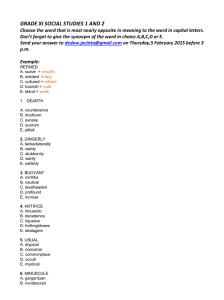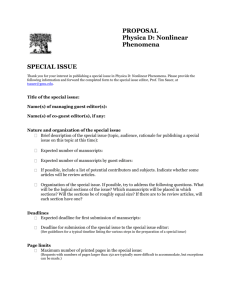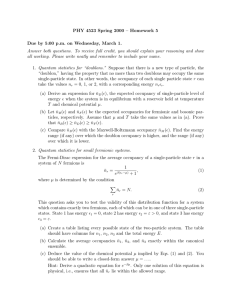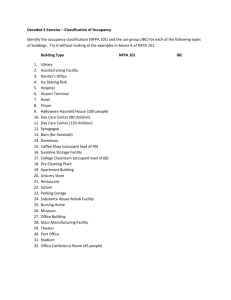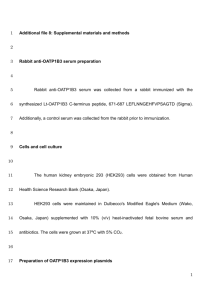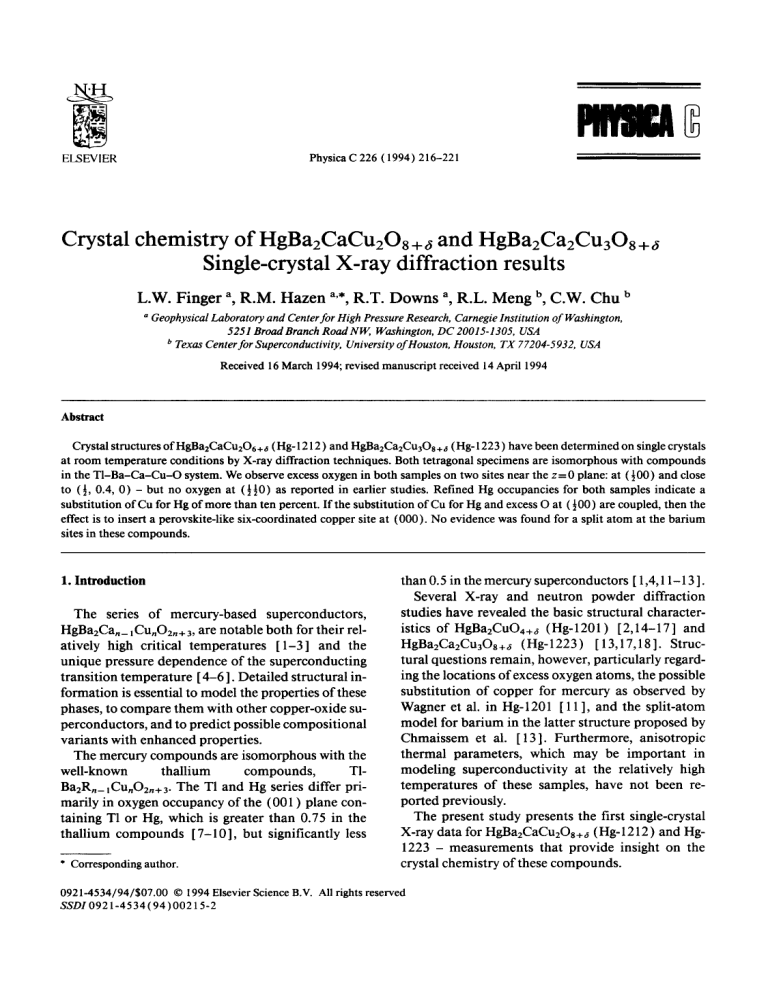
Phy~ca C 226 (1994) 216-221
ELSEVIER
Crystal chemistry of HgBa2CaCu208+ and HgBa2Ca2Cu308+
Single-crystal X-ray diffraction results
L . W . F i n g e r a R . M . H a z e n a'*, R . T . D o w n s a, R . L . M e n g b, C . W . C h u b
a Geophysical Laboratory and Center for High Pressure Research, Carnegie Institution of Washington,
5251 Broad Branch Road NW, Washington, DC 20015-1305, USA
b Texas Center for Superconductivity, University of Houston, Houston, TX 77204-5932, USA
Received 16 March 1994; revised manuscript received 14 April 1994
Abstract
Crystal structures of HgBa2CaCu206 +~ (Hg- 1212 ) and HgBa2Ca2Cu308 + a (Hg- 1223 ) have been determined on single crystals
at room temperature conditions by X-ray diffraction techniques. Both tetragonal specimens are isomorphous with compounds
in the T1-Ba-Ca-Cu-O system. We observe excess oxygen in both samples on two sites near the z=0 plane: at (½00) and close
to (½, 0.4, 0) - but no oxygen at (½½0) as reported in earlier studies. Refined Hg occupancies for both samples indicate a
substitution of Cu for Hg of more than ten percent. If the substitution of Cu for Hg and excess O at ( ½00) are coupled, then the
effect is to insert a perovskite-like six-coordinated copper site at (000). No evidence was found for a split atom at the barium
sites in these compounds.
1. Introduction
The series o f mercury-based superconductors,
HgBa2Can_i CUnO2n÷ 3, are notable both for their relatively high critical temperatures [ 1-3] and the
unique pressure dependence o f the superconducting
transition temperature [ 4 - 6 ]. Detailed structural information is essential to model the properties o f these
phases, to compare them with other copper-oxide superconductors, and to predict possible compositional
variants with enhanced properties.
The mercury compounds are isomorphous with the
well-known
thallium
compounds,
TIBa2R~_iCunO2n+3.The TI and Hg series differ primarily in oxygen occupancy o f the (001 ) plane containing T1 or Hg, which is greater than 0.75 in the
thallium compounds [ 7-10 ], but significantly less
* Corresponding author.
than 0.5 in the mercury superconductors [ 1,4,11-13 ].
Several X-ray and neutron powder diffraction
studies have revealed the basic structural characteristics o f HgBazCuO4+6 (Hg-1201) [2,14-17] and
HgBa2Ca2Cu3Os+~ (Hg-1223) [13,17,18]. Structural questions remain, however, particularly regarding the locations of excess oxygen atoms, the possible
substitution of copper for mercury as observed by
Wagner et al. in Hg-1201 [ 11 ], and the split-atom
model for barium in the latter structure proposed by
Chmaissem et al. [ 13 ]. Furthermore, anisotropic
thermal parameters, which may be important in
modeling superconductivity at the relatively high
temperatures o f these samples, have not been reported previously.
The present study presents the first single-crystal
X-ray data for HgBa2CaCu208+ 6 (Hg- 1212 ) and Hg1223 - measurements that provide insight on the
crystal chemistry of these compounds.
0921-4534/94/$07.00 © 1994 Elsevier Science B.V. All rights reserved
SSDI 0921-4534 (94)00215-2
L. W. Finger et al. / Physica C 226 (1994) 216-221
2. Experimental
2. I. Sample description
The Hg-1212 and Hg-1223 samples investigated
here were synthesized by the controlled vapor/solid
reaction technique [ 19 ] by heating a precursor pellet
of BaECaCu2Ox or Ba2Ca2Cu30 x (not compounds)
and a composite Hg-source in an evacuated quartz
tube. The precursor pellet was prepared by first dissolving appropriate amounts of Ba(NOa)2,
Ca(NO3)E-4H20, and Cu(NO3)E'2H20 in deionized water inside a beaker. The solution was slowly
stirred, heated, and finally dried into a blue powder,
which was removed from the beaker, ground, and
placed in an alumina crucible. It was then slowly
heated to between 500 and 550°C and kept at this
temperature for 0.5 h, before being further heated to
between 600 and 620°C, which temperature was
maintained for l h. The resulting black mixture was
then ground, compacted, and sintered in flowing oxygen at 900 °C for 24 h.
These precursor pellets were either used immediately, or else they were stored in a desiccator for later
use to minimize their exposure to humid air. Some
of the pellets were placed in a glove box where they
were pulverized, thoroughly mixed with HgO, and
compacted to form the composite Hg-source. A small
precursor pellet and a large composite Hg-source in a
mass ratio of ~0.3 were subsequently sealed in an
evacuated quartz tube, which was in turn placed inside a welded stainless steel tube as a safety measure,
heated to 800 to 850°C at a rate of 160°C/h, and
kept at this temperature for 5-6 h before cooling to
room temperature. The pellet was maintained at
300°C in flowing oxygen for l0 h for oxygenation.
Critical temperatures for these two samples at room
pressure are 127 and 134 K for Hg- 1212 and Hg- 1223,
respectively.
Crushing of this material revealed an average grain
size less than l0 ~m for both Hg-1212 and Hg-1223
specimens, though a few crystals up to 30 ~tm maximum dimension was recovered. We examined a
number of flat, rectangular crystals and selected euhedral specimens of Hg-1212 (approximately
3 0 X 3 0 × 10 ~tm) and of Hg-1223 (approximately
25 X 30 X 8 I~m) for further study.
217
2.2. Data collection and refinement
Intensity data were collected on a Rigaku AFC-5
four-circle diffractometer equipped with a rotatinganode generator operated at 45 kV and 180 mA. We
used graphite-monochromatized M o K a radiation
(2=0.7093 A) to measure a hemisphere of data to
(sin O)/2 = 0.71. Three reflections were monitored as
orientation and intensity standards every 150 reflections, and they showed no significant variation during the data collection.
Most diffraction maxima for both Hg- 1212 and Hg1223 were broad, and many of the observed peaks
were doublets, perhaps due to the stacking of multiple crystals in close alignment. One member of each
split diffraction peak (presumably the component
from the main crystal) was always well centered.
These centered peaks were integrated using a new
program that fit step-scan data to multiple constrained Gaussian doublets, corresponding to the
Kcq-Ka2 wavelengths of the Mo source. When more
than one doublet was present, only the central peak
was retained. Peaks that appeared to be single but significantly exceeded the expected peak width (implying an unresolved doublet) were rejected by this procedure. These reflections were corrected for Lorentz
polarization and absorption (#1=367.7 and 325.0
c m - 1for Hg- 1212 and Hg- 1223, respectively ) effects
and reduced to structure factors [20]. For Hg-1223,
the crystal description was not sufficient and an empirical correction was also included. Reflections were
averaged according to Laue group 4 / m m m , which
yielded 167 symmetrically distinct observations
(I>~3a) for Hg-1212 (Ri,t=0.032), and 169 reflections for Hg- 1223 (Rint = 0.048 ); however, all 1693
observations were used in the refinement of the empirical absorption correction.
We initiated the structure refinements with parameters reported for thallium isomorphs [ 10 ]. Our refinements included a scale factor, variable atomic coordinates, and anisotropic thermal parameters for all
fully-occupied sites. In addition, for both crystals we
refined Cu occupancy of the Hg sites at (000), oxygen occupancy parameters for atoms at ( ~ ~0) designated 0 3 in Hg- 1212 and 0 4 in Hg- 1223, and oxygen
occupancies for atoms at ( ½0~ 0) designated 0 4 and
0 5 in Hg- 1212 and Hg- 1223, respectively.
Refinements were performed with RFINE90, a
218
L. Iv.. Finger et al. / Physica C 226 (1994) 216-221
version o f R F I N E 4 [21 ]. A weight o f w = a - 2 ( F o )
was assigned to each reflection, where aFo is the error
derived from counting statistics, a n d the function,
Yw( IFol - IFcl )2, w a s m i n i m i z e d .
Initial refinement o f Hg-1212 i n c o r p o r a t e d six ato m s ( H g / C u , Ba, Ca, Cu, O1, and O 2 ) with isotropic t e m p e r a t u r e factors and an occupancy factor
for the H g / C u site. We used this refinement to generate a difference F o u r i e r m a p o f the (001 ) plane at
z = 0 (Fig. 1 ), in an effort to locate extra oxygen positions. Several previous studies have documented an
0 3 oxygen at ( ½½0) [ 13-16 ], while W a g n e r et al. observe a coupled substitution o f copper for Hg plus extra oxygen at ( ½00) in Hg- 1201 [ 11 ]. O u r difference
m a p reveals two p r o m i n e n t positive features. A maxi m u m at (½00), hereafter designated 0 4 , corresponds to the oxygen position observed by W a g n e r et
al.; we, too, observe significant Cu substitution on the
Hg site. A second m a x i m u m at a p p r o x i m a t e l y (½,
0.40, 0) is close to, but distinct from, the previously
reported partially filled " 0 3 " at (½ ½0). We propose
that 0 3 is, in fact, a split atom. The H g - O 3 a n d B a 0 3 distances resulting from this off-centering o f 0 3
are 2.46 and 2.83 A, respectively.
Final refinement o f Hg- 1212 with twenty variable
p a r a m e t e r s (one scale factor, one extinction p a r a m eter, five fractional coordinates, eight anisotropic
thermal p a r a m e t e r s for metal atoms, two isotropic
t e m p e r a t u r e factors for oxygen, a n d occupancies for
Hg, 0 3 , and O 4 ) , based on 167 observed reflections,
converged to a weighted R ( R w = a - 2 ( F o - F c ) 2 /
O'-2F 2)
of
0.035,
and
unweighted
R ( R = Y l IFol - IF¢l I/Y~ IFol ) o f 0.046. The goodness o f fit for the converged refinement is 1.1. Refined positional, thermal parameters, and occupancies for Hg-1212 a p p e a r in Table 1.
Initial refinement of Hg-1223 without extra 0 4 and
0 5 oxygens at (½10) a n d (½00), respectively, was
used to generate a difference F o u r i e r as described
above for Hg- 1212. Positive features at ( ½, 0.40, 0)
an ( ½00) were observed and included in subsequent
refinements. The Hg- 1223 refinement o f 25 p a r a m e ters, based on 1693 observations, converged to
weighted R = 0.069 and unweighted R = 0.092, with a
goodness o f fit = 2.0. Positional a n d thermal p a r a m eters are listed in Table 2. Refined occupancies o f the
Hg, 0 4 , a n d 0 5 are strongly correlated to temperature factors and the 0 4 occupancy, furthermore, is
inversely correlated to that o f Hg. Refined values o f
these occupancies, therefore, are not quantitatively
reliable. All refined models contain at least 10% Cu
on the Hg site a n d at least 10% occupancy o f O 5 . The
refined 0 4 occupancy, however, varies from less than
1% for a m o d e l with 18% Cu on Hg, to 25% for a
m o d e l with 10% Cu on Hg. F u r t h e r constraints on
Hg-1223 occupancies must await synthesis o f imTable 1
Refined structural parameters for Hg-1212at room temperature
X
L
1A
Atom
x
y
z
B (eq)
/q//ti a
Hg/Cu b
Ba
Ca
Cu
O1
02
03 c
04 e
0
½
½
0
0
0
½
½
0
!2
!2
0
½
0
0.40(4)
0
0
0.2205(2)
½
0.3765(3)
0.3758(11)
0.1553(18)
0
0
1.15(6)
0.65(5)
0.49(7)
0.46(6)
0.4(2)
1.0(4)
0.8 d
0.8
0.77
1.05
0.67
1.12
J
Fig. 1. Difference electron density map for the xy0 section of Hg1212. No defect oxygen sites are included in the calculated structure factors. Contour interval is approximately 0.4 e/,~ 3. The
positive features at ( ½00) and ( ½,0.4, 0), the negative feature at
( ½½0) and the substitution of Cu for Hg are the basis for the defect model proposed.
a #,/#± is the ratio of the rms amplitudes of vibration parallel
and perpendicular to the c axis.
b Refined Cu occupancy = 0.13 (2).
c Refined 03 occupancy = 0.10 (3).
d Isotropic temperature factors for 03 and 04 are fixed.
e Refined 04 occupancy = 0.12 ( 5 ).
L. W. Finger et al. / Physica C 226 (1994) 216- 221
Table 2
Refined structural parameters for Hg-1223 at room temperature
Atom
x
y
z
B (eq)
/tH//zI a
Hg/Cu b
Ba
Ca
Cul
Cu2
Ol
02
03
04 c
05 f
0
½
~
0
0
0
½
0
½
!2
0
½
½
0
0
½
0
0
0.36d
0
0
0.17491(8)
0.39758(28)
½
0.30068(17)
½
0.3060(7)
0.1228(12)
0
0
1.29(4)
0.68(2)
0.50(6)
0.43(5)
0.41(4)
0.3(2)
0.9(5)
1.7(7)
0.8 e
0.8
1.12
1.11
1.43
1.67
1.95
a #l//t± is the ratio of the rms amplitudes of vibration parallel
and perpendicular to the c axis.
Refined Cu occupancy= 0.18 ( 1).
c Refined 04 occupancy= 0.00 ( 2 ).
d y coordinate of 04 fixed at value determined from difference
electron density map.
e Isotropic temperature factors for 04 and 05 are fixed.
f Refined 05 occupancy= 0.13 (5).
Table 3
Selected interatomic distances (A) and Cu-O-Cu angles for Hg! 212 and Hg-1223 at room temperature
Bond
Hg-1212
Hg-O212]
Hg-O314]
Ba-Ol [4]
Ba-O214]
Ba-O3[1 ]
Ca-O1 [8]
1.97(2)
2.46(8)
2.757(10)
2.848(7)
2.83(2)
2.490(9)
Cu-O1 [4]
Cu-O2[1]
1.928(1)
2.81(2)
Cu-O1-Cu
179.5(9)
Bond
Hg-1223
Hg-O312]
Hg-O4[4l
Ba-O2 [4]
Ba-O314]
Ba-O4[1 ]
Ca-O1 [4]
Ca-O214]
Cul-O1 [4]
Cu2-O214]
Cu2-O3[1 ]
Cu2-O2-Cu2
1.975(19)
2.4(1)
2.824(8)
2.837(5)
2.81(2)
2.516(3)
2.413(7)
1.927(1)
1.929(1)
2.78(2)
175.4(7)
proved crystals or higher-resolution powder diffraction data.
Calculated and observed structure factors are
available from the authors.
3. R e s u l t s a n d d i s c u s s i o n
3.1. Structure o f HgBa2CaCu206+6
All known members o f the mercury superconductor series have tetragonal unit cells. We measured unit
219
cells for two Hg-1212 crystals (one crystal with
a = 3 . 8 5 5 4 ( 1 0 ) A, c = 12.693(7) A, V = 1 8 8 . 6 6 ( 1 3 )
A3; and the crystal used in intensity measurements
with a = 3 . 8 5 6 4 ( 9 )
A, c = 1 2 . 6 8 2 ( 4 ) A, V=
188.60 (9) ]~3), giving a calculated density o f 6.36 g/
cm 3.
Copper-oxygen, calcium-oxygen, and barium-oxygen bond distances in HgBa2CaCu206÷a are similar
to those observed in the isostructural c o m p o u n d
TIBa2CaCu207 [10,22]. The principal differences
occur in the substitution o f Hg (and Cu) for TI at
(000), and partial occupancy o f 0 3 at ( ½, 0.40, 0).
In the thallium c o m p o u n d the oxygen site at ( ~ 0 ) is
fully occupied, but in the mercury analogs the site is
significantly less than half occupied - 0.10 (3) in our
sample. Thus thallium is six-coordinated, while mercury is effectively two-coordinated. One consequence o f this coordination difference is that the H g 0 2 distance (parallel to c) is shorter than the T1-O
distance (1.97 (2) ~ for H g - O 2 compared to more
than 2.00 ~ for T1-O2). The mercury compound thus
displays a slightly shorter c axis than the thallium isomorph [22].
The Hg site in our sample incorporates 0.13 (2) Cu
- an amount balanced by the 0.12 (5) oxygen atoms
in the 0 4 site at (½00). The z coordinate o f O 4 may
deviate slightly from 0.00, but not by more than 0.4
A, based on electron density maps.
3.2. Structure o f HgBa2CaeCu308+,~
The Hg-1223 unit cell is a = 3 . 8 4 2 ( 5 ) /~,
c = 15.832(8) ~,, V = 2 3 3 . 5 8 ( 4 4 ) ]~3, giving a calculated density of 6.21 g / c m 3.
C0pper-oxygen and calcium-oxygen b o n d distances are typical o f other 1223-type superconductors [ 10 ], while these distances and those o f H g - O
agree closely with room-temperature values reported
by Chmaissem et al. [ 13 ] based on neutron powder
diffraction. In particular, we observe in-plane Cu 1O l and C u 2 - O 2 distances of 1.927 (1) and 1.929 (1)
]~, respectively, compared to 1.925 for both distances
reported by Chmaissem et al. We observe mean C a O, Hg-O3, and H g - O 4 o f 2.452(5), 1.97(2), and
2.4(1) /~, compared to 2.493(6), 1.95(1), and
2.7225 ( 1 ) for the neutron study. The H g - O 3 bond,
which is parallel to the c axis, is significantly shorter
than the T1-O3 distance (greater than 2.0 ~ ) ob-
220
L.W. Finger et al. /Physica C 226 (1994) 216-221
served in the thallium isomorph [ 10 ]. The relatively
short Hg-O distances in both mercury compounds of
this study point to stronger interlayer coupling, which
may contribute to the unusually high To.
Observed barium--oxygen distances conform to
those of T1Ba2Ca2Cu3Og: approximately 2.83 A in
both samples [8]. These Ba-O distances, however,
are significantly different from values reported by
Chmaissem et al. [ 13 ], who suggest that Ba may be
modeled as a split atom with approximately half Ba
displaced by 0.25 A above and below the centric position, ( 1~z). We observe no evidence for this splitting in refinements of single-crystal X-ray data. In
fact, anisotropic temperature parameters are well behaved and reveal near-isotropic barium vibration
with relatively small rms displacements, typical of
nine-coordinated Ba in other oxides. These discrepancies between X-ray single crystal and neutron powder data may reflect differences in sample order.
Refined anisotropic thermal parameters reveal that
the motions of mercury, calcium, barium, and oxygen atoms are close to isotropic, probably reflecting
the uniform coordination of these atoms. Ratios of
maximum to minimum vibration amplitudes for
these atoms are less than 1.5. The two symmetrically
distinct copper atoms, on the other hand, display
elongated thermal motion parallel to [001 ] with atom
displacements approaching two times greater parallel
to c than parallel to a - an anisotropy typical of that
observed in other structures with square-planar cation coordination.
3.3. Revised structural forrnulae for Hg
superconductors
The observation by Wagner et al. and us of coupled
substitution of approximately equal amounts of Cu
for Hg at (000) and O on a new site at (½00), requires a structural formula that acknowledges the
presence of excess oxygen on two distinct sites. Our
sample of Hg-1212, for example, may be described
as: (Hgo.sTCU0.~3)Ba2CaCu206.22. But, in more general terms, two oxygen ~ terms are required:
(Hgl_61Cu61)Ba2CaCu206+al+a2, where J1 and ~2
represent the fractional occupancies of oxygen at
(½00) and (½, 0.40, 0), respectively. Further structural investigations, coupled with synthesis and ana-
lytical studies, will be required to resolve the details
of this complex system.
Although the diffraction data for these experiments do not have the quality required to answer all
questions regarding defect structures, the equality
between the amount of Cu substitution in the Hg position and the amount of O at (½00) is suggestive of
partial substitution of a perovskite-like, octahedrally
coordinated, Cu layer in both Hg-1212 and Hg-1223
samples. Because the substitution of Cu for Hg is not
found in some studies [ 14,15 ], this effect may be due
to some aspect of the synthesis. Alternatively, the distinctive characteristics of our sample may reflect the
selection of the largest, most regular - and therefore
possibly atypical - single crystals in otherwise finegrained samples.
Acknowledgements
We acknowledge the important contributions of
J.D. Jorgensen and an anonymous reviewer of an
earlier version of this manuscript. Crystal synthesis
was performed at the Texas Center for Superconductivity, which is jointly supported by NSF grant DMR
91-22045 and USAFOSR Grant F49620-93-1-0310
by BMDO, and the State of Texas. X-ray diffraction
work at the Geophysical Laboratory is supported by
NSF grant EAR92-18845 and by the Carnegie Institution of Washington.
References
[ 1 ] S.N. Putilin, E.V. Antipov, O. Chmaissen and M. Marezio,
Nature 362 ( 1993 ) 226.
[2] A. Schilling, M. Cantoni, J.D. Gao and H.R. Ott, Nature
363 (1993) 56.
[3] Z.J. Huang, R.L. Meng, X.D. Qui, Y.Y. Sun, J. Kulik, Y.Y.
Xue and C.W. Chu, Physica C 217 ( 1993 ) 1.
[4] C.W. Chu, L. Gao, F. Chen, Z.J. Huang, R.L. Meng and
Y.Y. Xue, Nature 365 (1993) 323.
[5] M. Nunez-Regueiro, J.L. Tholence, E.V. Antipov, J.J.
Capponi and M. Marezio, Science 262 (1993) 97.
[6] L. Gao, Y.Y. Xue, F. Chen, Q. Xiong, R.L. Meng, D.
Ramirez, C.W. Chu, J.H. Eggert and H.K. Mao, Phys. Rev.
Lett. (1994), in press.
[7] S.S.P. Parkin, V.Y. Lee, A.I. Nazzal, R. Savoy, R. Beyers
and S. LaPlaca, Phys. Rev. Lett. 61 ( 1988 ) 750.
[ 8] B. Moroson, D.S. Ginley, J.E. Schirber and E.L. Venturini,
Physica C 156 (1988) 587.
L. W.. Finger et al. / Physica C 226 (1994) 216--221
[9]M.A. Subramanian, J.C. Calabrese, C.C. Torardi, J.
Gopalakrishnan, T.R. Askew, R.B. Flippen, K.J. Morrissey,
U. Chowdhry and A.W. Sleight, Nature 332 ( 1988 ) 420.
[ 10] R.M. Hazen, in: Physical Properties of High Temperature
Superconductors, Vol. 2, ed. D.M. Ginsberg (1990) p. 121.
[ 11 ] J.L. Wagner, P.G. Radaelli, D.G. Hinks, J.D. Jorgensen, J.F.
Mitchell, B. Dabrowski, G.S. Knapp and M.A. Beno, Physica
C 210 (1993) 447.
[ 12] O. Chmaissem, Q. Huang, S.N. Putilin, M. Marezio and A.
Santoro, Physica C 212 ( 1993 ) 259.
[13 ] O. Chmaissem, Q. Huang, E.V. Antipov, S.N. Putilin, M.
Marezio, S.M. Loureiro, J.J. Capponi, J.L. Tholence and A.
Santoro, Physica C 217 (1994) 265.
[14] P.G. Radaelli, J.L. Wagner, B.A. Hunter, M.A. Beno, G.S.
Knapp, J.D. Jorgensen and D.G. Hinks, Physica C 216
(1993) 29.
[ 15] E.V. Antipov, J. Capponi, C. Chaillout, O. Chmaissem, S.M.
Loureiro, M. Marezio, S.N. Putilin, A. Santoro and J.L.
Tholence, Physica C 218 (1993) 348.
221
[ 16] Q. Huang, J.W. Lynn, R.L. Meng and C.W. Chu, Physica C
218 (1993) 356.
[17] B.A. Hunter, J.D. Jorgensen, J.L. Wagner, P.G. Raedelli,
D.G. Hinks, H. Shaked, R.L. Hitterman and R.B.
VonDreele, Physica C 221 (1994) 1.
[ 18] E.V. Antipov, S.M. Loureiro, C. Chaillout, J.J. Capponi, P.
Bordet, J.L. Tholence, S.N. Putilin and M. Marezio, Physica
C215 (1993) 1.
[ 19] R.L. Meng, L. Beauvais, Z.N. Zhang, Z.J. Huang, Y.Y. Sun,
Y.Y. Xue and C.W. Chu, Physica C 216 ( ! 993 ) 21.
[20] C.W. Burnham, Am. Mineral. 51 (1966) 159.
[ 21 ] L.W. Finger and E. Prince, Natl. Bur. Standards Tech. Note
854 (1975) p. 128.
[22]B. Morosin, D.S. Ginley, P.F. Hlava, M.J. Carr, R.J.
Baughman, J.E. Schirber, E.L. Venturini and J.F. Kwak,
Physica C 152 ( 1988 ) 413.

